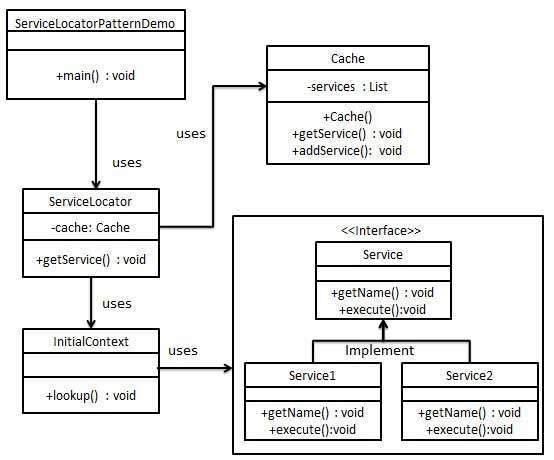Design Pattern - Service Locator Pattern--转载
原文地址:http://www.tutorialspoint.com/design_pattern/service_locator_pattern.htm
The service locator design pattern is used when we want to locate various services using JNDI lookup. Considering high cost of looking up JNDI for a service, Service Locator pattern makes use of caching technique. For the first time a service is required, Service Locator looks up in JNDI and caches the service object. Further lookup or same service via Service Locator is done in its cache which improves the performance of application to great extent. Following are the entities of this type of design pattern.
Service - Actual Service which will process the request. Reference of such service is to be looked upon in JNDI server.
Context / Initial Context - JNDI Context carries the reference to service used for lookup purpose.
Service Locator - Service Locator is a single point of contact to get services by JNDI lookup caching the services.
Cache - Cache to store references of services to reuse them
Client - Client is the object that invokes the services via ServiceLocator.
Implementation
We are going to create a ServiceLocator,InitialContext, Cache, Service as various objects representing our entities.Service1 and Service2 represent concrete services.
ServiceLocatorPatternDemo, our demo class, is acting as a client here and will useServiceLocator to demonstrate Service Locator Design Pattern.

Step 1
Create Service interface.
Service.java
public interface Service {
public String getName();
public void execute();
}
Step 2
Create concrete services.
Service1.java
public class Service1 implements Service {
public void execute(){
System.out.println("Executing Service1");
}
@Override
public String getName() {
return "Service1";
}
}
Service2.java
public class Service2 implements Service {
public void execute(){
System.out.println("Executing Service2");
}
@Override
public String getName() {
return "Service2";
}
}
Step 3
Create InitialContext for JNDI lookup
InitialContext.java
public class InitialContext {
public Object lookup(String jndiName){
if(jndiName.equalsIgnoreCase("SERVICE1")){
System.out.println("Looking up and creating a new Service1 object");
return new Service1();
}
else if (jndiName.equalsIgnoreCase("SERVICE2")){
System.out.println("Looking up and creating a new Service2 object");
return new Service2();
}
return null;
}
}
Step 4
Create Cache
Cache.java
import java.util.ArrayList;
import java.util.List; public class Cache { private List<Service> services; public Cache(){
services = new ArrayList<Service>();
} public Service getService(String serviceName){ for (Service service : services) {
if(service.getName().equalsIgnoreCase(serviceName)){
System.out.println("Returning cached " + serviceName + " object");
return service;
}
}
return null;
} public void addService(Service newService){
boolean exists = false; for (Service service : services) {
if(service.getName().equalsIgnoreCase(newService.getName())){
exists = true;
}
}
if(!exists){
services.add(newService);
}
}
}
Step 5
Create Service Locator
ServiceLocator.java
public class ServiceLocator {
private static Cache cache;
static {
cache = new Cache();
}
public static Service getService(String jndiName){
Service service = cache.getService(jndiName);
if(service != null){
return service;
}
InitialContext context = new InitialContext();
Service service1 = (Service)context.lookup(jndiName);
cache.addService(service1);
return service1;
}
}
Step 6
Use the ServiceLocator to demonstrate Service Locator Design Pattern.
ServiceLocatorPatternDemo.java
public class ServiceLocatorPatternDemo {
public static void main(String[] args) {
Service service = ServiceLocator.getService("Service1");
service.execute();
service = ServiceLocator.getService("Service2");
service.execute();
service = ServiceLocator.getService("Service1");
service.execute();
service = ServiceLocator.getService("Service2");
service.execute();
}
}
Step 7
Verify the output.
Looking up and creating a new Service1 object
Executing Service1
Looking up and creating a new Service2 object
Executing Service2
Returning cached Service1 object
Executing Service1
Returning cached Service2 object
Executing Service2
Design Pattern - Service Locator Pattern--转载的更多相关文章
- [Design Pattern] Service Locator Pattern 简单案例
Service Locator Pattern,即服务定位模式,用于定位不同的服务.考虑到 InitialContext::lookup 的成本比较高,提供了 Cache 类缓存以定位到的服务. 代码 ...
- Service Locator Pattern 服务定位
https://www.geeksforgeeks.org/service-locator-pattern/ Service Locator Pattern Last Updated: 06-03-2 ...
- .NET 服务器定位模式(Service Locator Pattern)——Common Service Locator
本文内容 场景 目标 解决方案 实现细节 思考 相关模式 更多信息 参考资料 Common Service Locator 代码很简单,它一般不会单独使用,而是作为一个单件模式,与像 .net Uni ...
- 《Prism 5.0源码走读》Service Locator Pattern
在Prism Bootstrapper里面取实例的时候使用 ServiceLocator模式,使用的是CommonServiceLocator库 (http://commonservicelocato ...
- [Architecture Pattern] Singleton Locator
[Architecture Pattern] Singleton Locator 目的 组件自己提供Service Locator模式,用来降低组件的耦合度. 情景 在开发系统时,底层的Infrast ...
- Atitit。如何实现dip, di ,ioc ,Service Locator的区别于联系
Atitit.如何实现dip, di ,ioc ,Service Locator的区别于联系 1. Dip原则又来自于松耦合思想方向1 2. 要实现dip原则,有以下俩个模式1 3. Ioc和di的 ...
- 【转】Understanding Inversion of Control, Dependency Injection and Service Locator Print
原文:https://www.dotnettricks.com/learn/dependencyinjection/understanding-inversion-of-control-depende ...
- Service Locator 模式
什么是Service Locator 模式? 服务定位模式(Service Locator Pattern)是一种软件开发中的设计模式,通过应用强大的抽象层,可对涉及尝试获取一个服务的过程进行封装.该 ...
- [Design Patterns] 3. Software Pattern Overview
When you're on the way which is unknown and dangerous, just follow your mind and steer the boat. 软件模 ...
随机推荐
- Vue style里面使用@import引入外部css, 作用域是全局的解决方案
问题描述 使用@import引入外部css,作用域却是全局的 <template> </template> <script> export default { na ...
- python 面向对象 继承
什么是继承 继承表达的是一种”是“的关系,比如人是动物 继承是一种创建新类的方式,在python中,新建的类可以继承一个或多个父类,父类又可称为基类或超类,新建的类称为派生类或子类 继承是基于抽象的结 ...
- C#打开或者创建一个文件,然后向其末尾写入数据的方法
原文:C#打开或者创建一个文件,然后向其末尾写入数据的方法 FileStream fs = new FileStream(@"d:\timetick.txt" ...
- Redis介绍以及安装具体解释
redis是一个key-value存储系统. 和Memcached类似.它支持存储的value类型相对很多其它,包含string(字符串).list(链表).set(集合).zset(sorted s ...
- 最多包含2/k个不同字符的最长串
看这里的解答: http://www.cnblogs.com/grandyang/p/5351347.html 通用解决了2和k的问题.
- oracle 存储过程定义及调试,并终于被C# 调用 代码
C# 调用存储过程 參考了非常多文章,写了例如以下文字,算是分享吧 目的:更改积分,并作一定校验 一.一般的调试方法: 方法一:带返回out參数,必须定义变量 myresult DECLARE myr ...
- action support分析
Action这一部分主要是数据(索引)的操作和部分集群信息操作. 所有的请求通过client转发到对应的action上然后再由对应的TransportAction来执行相关请求.如果请求能在本机上执行 ...
- Minikube之Win10单机部署Kubernetes(k8s)自动化容器操作的开源平台
Minikube之Win10单机部署 Kubernetes(k8s)是自动化容器操作的开源平台,基于这个平台,你可以进行容器部署,资源调度和集群扩容等操作.如果你曾经用过Docker部署容器,那么可以 ...
- Vue Syntax Highlight
Vue Syntax Highlight https://github.com/vuejs/vue-syntax-highlight
- 使用Chrome浏览器,让我们远离(所有)广告
你是否还在为浏览网页时各种广告霸屏而急躁不安?这里分享一个小技巧,如何自动屏蔽各大广告. 这里使用的浏览器是Chrome,直接在Chrome网上应用商店搜索下载安装AdBlock插件(不知道其它浏览器 ...
